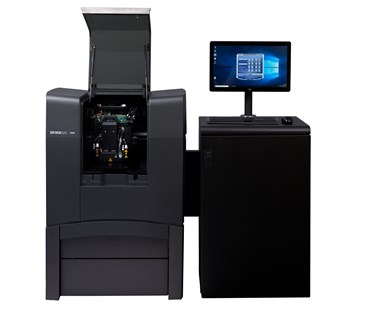Additive Manufacturing: New Mid-Range 3D Printer
The new J826 from Stratasys is a lower cost option that broadens access to full-color, seven-material PolyJet 3D printing for enterprise shops and educational institutions.
Stratasys has launched its new J826 3D printer, the latest in its family of J8-series PolyJet printers. The J826 is a lower cost alternative and features full Pantone-validated color and multi-material 3D printing.

The Stratasys J826 3D printer extends its J8-series 3D printers to mid-volume enterprise shops and educational institutions.
The J826 is targeted for designers and the company claims that the printer will create highly realistic prototypes that help achieve the intent of the designer, bringing them to life much faster and increasing quality with more design iterations. The J826 is particularly suited for enterprises with mid-volume modeling requirements in industries such as consumer goods and electronics, automotive, and educational institutions. For instance, Cambridge, UK-based BiologIC Technologies is using the J826 3D printer to develop advanced medical instrumentation, which is described as a ‘desktop PC of life sciences.’
Built as a mid-range full-color 3D printer for enterprise shops, the J826 reportedly supports the full design process with same day send-to-print and easy post-processing. It provides the same resolution and detail as other Stratasys J8-series 3D printers, with models matching the shape, material, color and finish of final products.
The J826 is expected to be available to order in May 2020.
The J826 3D printer leverages the same PolyJet materials as the J850, meeting the needs of both designers and design engineers. It includes the full range of textures, transparency with the VeroUltraClear material, and PANTONE-validated color. Fully supported by GrabCAD print software, it enables an import of common CAD formats (e.g. Solidworks).
The J826 3D printer features a maximum build volume size of 10” x 9.9” x 7.9” (255mm x 252mm x 200mm). Like other J8-series printers, the large, seven-material capacity means operators can load their most frequently used resins and avoid downtime associated with material changeovers. Multiple print modes let users adjust the speed and quality of the print to meet specific needs, from high quality mode to high speed mode.
Related Content
-
More Efficient, Precise Blending and Drying Solutions
NPE2024: ABS debuts new blending, drying and repelletizing products in Orlando, plus a new color analyzer.
-
Multilayer Solutions to Challenges in Blow Molding with PCR
For extrusion blow molders, challenges of price and availability of postconsumer recycled resins can be addressed with a variety of multilayer technologies, which also offer solutions to issues with color, processability, mechanical properties and chemical migration in PCR materials.
-
How to Optimize Color Evaluation of Recycled Plastics
The right color measurement instrument and good working methods will minimize variability in color evaluation of PCR.








